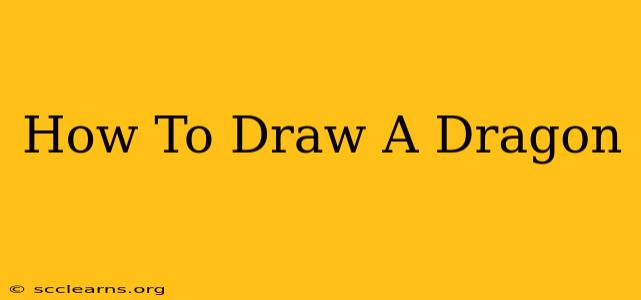Dragons! Majestic creatures of myth and legend, soaring through the skies and guarding ancient treasures. Learning how to draw a dragon can be a rewarding experience, regardless of your skill level. This guide provides a step-by-step approach, catering to both beginners and those looking to refine their dragon-drawing techniques. We'll cover various styles, from cartoonish dragons to more realistic, intimidating beasts. Let's unleash your inner artist!
Understanding Dragon Anatomy: The Foundation of a Great Drawing
Before you begin sketching, understanding the basic anatomy of a dragon will significantly improve your results. While dragons are mythical, they often incorporate elements from real-world animals. Consider these aspects:
-
Body Structure: Think of a dragon's body as a combination of serpentine and reptilian features. A long, flexible body, powerful legs, and a strong tail are key components. Experiment with different body proportions to create unique dragon designs.
-
Wings: Dragon wings can range from bat-like membranes to more feathered or leathery textures. Observe bird wings for inspiration on wing structure and feather placement (if applicable). Consider the wingspan relative to the body size – a larger wingspan suggests a more powerful creature.
-
Head and Horns: The head is often the focal point of a dragon drawing. Pay attention to the shape of the snout, the placement of eyes, and the presence of horns, crests, or other facial features. These details contribute significantly to the dragon's personality and overall appearance.
-
Claws and Teeth: Sharp claws and menacing teeth are quintessential dragon features. Careful detailing in these areas can greatly enhance the realism and ferocity of your drawing.
Step-by-Step Guide: Drawing a Classic Dragon
This section focuses on drawing a more traditional, Western-style dragon. Follow these steps to create your own magnificent beast:
Step 1: Sketching the Basic Shape: Begin with simple shapes. Use ovals and circles to outline the body, head, and legs. Don't worry about details yet; focus on the overall posture and proportions.
Step 2: Refining the Body: Connect the basic shapes to form the dragon's body. Smooth out the lines, adding curves and details to create a more fluid form. Pay attention to the musculature, suggesting strength and power in the limbs and torso.
Step 3: Adding Wings and Legs: Sketch in the wings, paying close attention to their structure and size. Define the legs, including the claws and toes. Ensure that the limbs are proportionally sized and accurately placed.
Step 4: Detailing the Head: Add details to the head, such as eyes, nostrils, horns, and mouth. Consider the expression you want to convey – fierce, wise, or playful.
Step 5: Adding Scales and Textures: Use various lines and shading techniques to create the illusion of scales and textures. Experiment with different scale patterns and sizes to add visual interest.
Step 6: Final Touches and Shading: Refine your lines, erase unnecessary guidelines, and add shading to create depth and dimension. Consider adding a background to enhance your dragon's presence.
Different Dragon Styles: Exploring Creativity
Don't limit yourself to one style! Experiment with different approaches:
-
Cartoon Dragons: Simpler shapes and exaggerated features create a fun, playful look.
-
Eastern Dragons: These often have serpentine bodies, antlers, and a more elegant appearance compared to Western dragons.
-
Realistic Dragons: Focus on anatomical accuracy and detail, paying close attention to musculature, scales, and textures.
-
Fantasy Dragons: Blend different styles and add unique elements to create your own imaginative dragon designs.
Tips for Improving Your Dragon Drawings:
-
Practice Regularly: The more you draw, the better you'll become.
-
Study Dragon Anatomy: Observe real animals for inspiration on how to depict muscles, movement, and textures.
-
Experiment with Different Mediums: Try different pencils, pens, or digital tools to find your preferred style.
-
Seek Feedback: Share your work with others and ask for constructive criticism.
-
Use Reference Images: Looking at pictures of dragons and other animals can inspire your creativity.
Drawing dragons is a journey of creativity and skill development. With practice and dedication, you'll be able to create breathtaking and unique dragon art. So grab your pencils and let your imagination soar!

